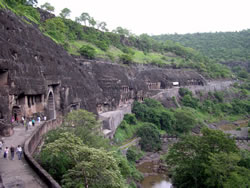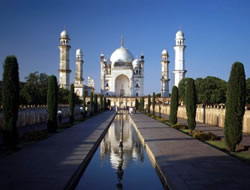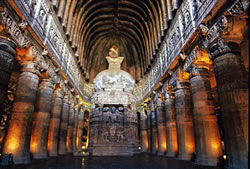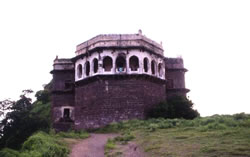 The city that Mughal emperor Aurangzeb built in the dusk of his empire is Aurangabad, the city that is base to the marvels of man - the Ajanta and Ellora caves. Situated in Maharashtra, Aurangabad today is a thriving industrial metropolis and apart from being the jump-off point for Maharashtra's most celebrated tourist attraction, it also merits as one of the cleanest cities in the country.
The city that Mughal emperor Aurangzeb built in the dusk of his empire is Aurangabad, the city that is base to the marvels of man - the Ajanta and Ellora caves. Situated in Maharashtra, Aurangabad today is a thriving industrial metropolis and apart from being the jump-off point for Maharashtra's most celebrated tourist attraction, it also merits as one of the cleanest cities in the country.
With a lot to offer the avid tourist including incredible Deccan Mughal architecture, the most pleasant feature of Aurangabad is its inhabitants. Retaining the charms and mannerisms of the Nizams, they are courteous, polite and extremely helpful.
If the Ajanta and Ellora caves figure in your travel plans, as they should, make it a point to spend a couple of days in Aurangabad. You will not be disappointed.
Population : Approx 2.9 million
Climate : The summers sizzle with maximum temperatures hitting 40°C in May and winters are warm, with maximum temperatures falling to approximately 29°C. You could also visit Aurangabad between October and March, when the weather is pleasant.
Best times to visit : Between the months of June and September and from October to March.
Bibi ka Maqbara
 One more tribute from a man to a woman, only this time, from a son to a mother. Modelled on the Taj Mahal, Aurangabad's Mughal tomb garden was built by Prince Azam Khan in memory of his mother, Begum Rabia Daurani.
One more tribute from a man to a woman, only this time, from a son to a mother. Modelled on the Taj Mahal, Aurangabad's Mughal tomb garden was built by Prince Azam Khan in memory of his mother, Begum Rabia Daurani.
Completed in 1678 this poor man's Taj Mahal has largely drawn flak as a cheap imitation of the Taj but take a look at it anyway. May not be the marble glory that the Taj Mahal is, but is worth a dekko anyway.
Purwar Museum
This wonderful personal collection is housed in a lovely haveli and is the work of a retired doctor Mr. Purwar. Small and not given to the excesses that other museums are given to, the exhibits here include a 500-year-old chain mail suit, an 800-year-old Paithani sari and a copy of the Koran handpainted by Aurangzeb. To provide it perfect company is the antique shop next to it. You will find the place on Ghati road.
The Ajanta Caves
 About 107 kms from the city of Aurangabad, the rock cut caves of Ajanta nestle in a panoramic gorge, in the form of a gigantic horseshoe. Among the finest examples of some of the earliest Buddhist architecture, cave paintings and sculptures, these caves comprise Chaitya Halls, or shrines dedicated to Lord Buddha and Viharas or monasteries used by Buddhist monks for meditation and the study of Buddhist teachings. The paintings that adorn the walls and ceilings of the caves depict incidents from the life of Buddha and various Buddhist divinities. Among the more interesting paintings are the jakata tales, illustrating diverse stories relating to the previous incarnations of the Buddha as Bodhisattva, a saintly being who is destined to become Buddha. Occupied for almost 700 years the caves of Ajanta seem to have been abandoned rather abruptly. They remained shrouded in obscurity upon them while on a hunting expedition in 1819. The viewpoint from where John Smith first glimpsed the caves provides a magnificent sight of the U-Shaped gorge and its scenic surroundings. Ajanta has been designated as a World Heritage Site, to be preserved as an artistic legacy that will come to inspire and enrich the lives of generations to come.
About 107 kms from the city of Aurangabad, the rock cut caves of Ajanta nestle in a panoramic gorge, in the form of a gigantic horseshoe. Among the finest examples of some of the earliest Buddhist architecture, cave paintings and sculptures, these caves comprise Chaitya Halls, or shrines dedicated to Lord Buddha and Viharas or monasteries used by Buddhist monks for meditation and the study of Buddhist teachings. The paintings that adorn the walls and ceilings of the caves depict incidents from the life of Buddha and various Buddhist divinities. Among the more interesting paintings are the jakata tales, illustrating diverse stories relating to the previous incarnations of the Buddha as Bodhisattva, a saintly being who is destined to become Buddha. Occupied for almost 700 years the caves of Ajanta seem to have been abandoned rather abruptly. They remained shrouded in obscurity upon them while on a hunting expedition in 1819. The viewpoint from where John Smith first glimpsed the caves provides a magnificent sight of the U-Shaped gorge and its scenic surroundings. Ajanta has been designated as a World Heritage Site, to be preserved as an artistic legacy that will come to inspire and enrich the lives of generations to come.
The Ellora Caves
 The cave temples and monasteries at Ellora, excavated out of the vertical face of an escarpment are 26 kms north of Aurangabad. Extending in a linear arrangement, the 34 caves contain Buddhist Chaityas, or halls of worship, and Viharas, or monasteries, Hindu and Jain temples. Spanning a period of about 600 years between the 5th and the 11th century A.D., the earliest excavation here is of the Dhumar Lena (cave 29). The most imposing excavation is, without doubt that of the magnificent Kailasa Temple (cave 16), which is the single largest monolithic structure in the World. Interestingly Ellora, unlike the sight of Ajanta was never rediscovered. Known as Verul in ancient times, it has continuously attracted pilgrims through the centuries. Ellora has been designated a World Heritage Site, to be preserved as an artistic legacy that will come to inspire and enrich the lives of generations to come.
The cave temples and monasteries at Ellora, excavated out of the vertical face of an escarpment are 26 kms north of Aurangabad. Extending in a linear arrangement, the 34 caves contain Buddhist Chaityas, or halls of worship, and Viharas, or monasteries, Hindu and Jain temples. Spanning a period of about 600 years between the 5th and the 11th century A.D., the earliest excavation here is of the Dhumar Lena (cave 29). The most imposing excavation is, without doubt that of the magnificent Kailasa Temple (cave 16), which is the single largest monolithic structure in the World. Interestingly Ellora, unlike the sight of Ajanta was never rediscovered. Known as Verul in ancient times, it has continuously attracted pilgrims through the centuries. Ellora has been designated a World Heritage Site, to be preserved as an artistic legacy that will come to inspire and enrich the lives of generations to come.
The Caves
Aurangabad seems to have more than its share of secondary monuments and sights. Like the Aurangabad caves, which are no patch on the splendid Ajanta and Ellora caves. Having said that, these caves are a good introduction to rock-cut architecture.
3 kms north of the city, the caves have been carved out of a steep spur of the Sahyadri Range. A great view of the city, serenity and a piece of history are what you get to take back from here. The Aurangabad caves are Buddhist and are divided into two groups by the archaeological survey of India as the western and eastern caves.
Daulatabad
 13 km away from Aurangabad lies one of the country's most impressive and majestic forts, commanding the view from atop a pyramid-shaped hilltop. It is an unusually large fortress and is surrounded by huge, imposing grey, granite walls and has a central, slender pink minaret called the Chandminar - a Victory tower built in 1435 and is right on top of the hill, originally known as Devagiri or the Hill of the Gods. There is also a 15 m deep moat encircling the upper portion of the citadel.
13 km away from Aurangabad lies one of the country's most impressive and majestic forts, commanding the view from atop a pyramid-shaped hilltop. It is an unusually large fortress and is surrounded by huge, imposing grey, granite walls and has a central, slender pink minaret called the Chandminar - a Victory tower built in 1435 and is right on top of the hill, originally known as Devagiri or the Hill of the Gods. There is also a 15 m deep moat encircling the upper portion of the citadel.
In 1294, the Delhi Sultans stormed Daulatabad and looted its wealth, paving the way for eccentric Mughal ruler Mohammed bin Tughlaq, who took over the fort in 1327. He renamed it Daulatabad, the City of Fortune and made it his southern military operations base.
Khuldabad
Khuldabad is a walled city also known as Rauza and famed as the 'Heavenly Abode'. It contains within its walls the karbala (holy shrine) for Muslims in the Deccan region. The courtyard of the Alamgir Dargah (shrine) is also the burial spot of the last great Mughal emperor, Aurangzeb. His grave is a simple open one, decorated by the fresh flower petals that visitors bring.
Aurangzeb chose Khuldabad as his final resting place because the mausoleum of Sayeed Zain-ud-din, a Muslim holy man lies next door. The Robe of the Prophet, which is considered an important relic lies here and revealed to the public once a year, on the 12th day of the Islamic month of Rabi-ul-Awwal.
Grishneshwar Mandir
Rani Ahilyabai Holkar is said to have built this Shiva temple in the 18th century in small village of Grishneshwar, which lies west of the caves. It houses one of the 12 'self born' jyotirlingas (the phallic symbol of the Lord Shiva) thought to date back to the 2nd century BC. There are no rules banning non-Hindus from the temple and allowed to join the queue for a glimpse of the deity. Men will need to take off their shirts before entering the temple though.
Paithan
An ancient town that lies 56 km south of Aurangabad, Paithan is renowned for its famous Paithani silk saris. The beautiful 6-yard Paithani sari is woven with pure silk yarn and gold thread (drawn from pure gold). It is a matter of pride that this 2000-year-old art of weaving continues, with families passing on their creative skills to younger generations.
A heavy brocade Paithani takes at least 6 months to complete and costs over Rs 50,000, while an ordinary Paithani sari takes about a month to complete and costs between Rs 8,000 and Rs 15,000. The State weaving centre has lovely Paithani wall pieces as well.
Ellora Festival
The third week of March every year, Aurangabad dons the mantle of host and gears up for a festival of music and dance. This festival is organized by the Maharashtra Tourism Development Corporation (MTDC). The city decks up with lights in anticipation for this time and event.
The Ellora festival is conducted at the Aurangabad Caves, an ambience that succeeds in giving its audience a feeling of beauty and mystery. Sitting in the caves and listening to some of the best singers perform, one is almost transported to another time and the magic of an era that revelled in the beautiful.